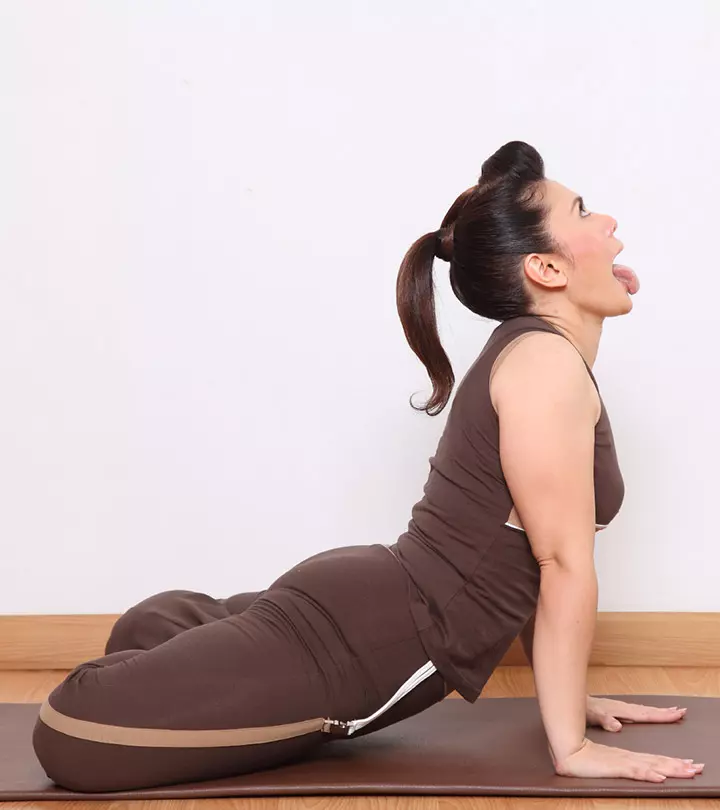How To Do The Kapotasana And What Are Its Benefits
Discover a powerful backbend flow that enhances flexibility, strength, and well-being daily.

Image: ShutterStock
Kapotasana or Pigeon Pose is an asana. Sanskrit: कपोतासन; Kapot = Pigeon, Asana = Pose. Pronounced as KAH-put-AWS-ah-nuh
The name comes from the Sanskrit words kapota (कपोत) meaning “pigeon”, and asana (आसन) meaning “posture”. When one assumes the pose, it looks just as graceful as the bird is. With this asana, you will find more freedom and energy in your spine and your mind. It has a whole lot of benefits and also gives your body a good stretch. It is a must to include this asana in your yoga practice.
Everything You Need To Know About Kapotasana
- What You Should Know Before You Do The Kapotasana
- How To Do Kapotasana (Pigeon Pose)
- Contraindications And Precautions
- Beginner’s Tips
- Advanced Pose Variations
- The Benefits Of Pigeon Pose (Kapotasana)
- Preparatory Poses
- Follow-Up Poses
What You Should Know Before You Do The Kapotasana
For this asana, it is essential that your bowels and stomach are absolutely empty, with a gap of at least four to six hours between your meal and the practice. This will also give your body enough time to digest the food and expend the energy produced.
It is a good idea to practice this asana early in the morning. But if you are not a morning person, you could practice this asana in the evening.
Level: Beginner
Style: Ashtanga Yoga
Duration: 1 Minute
Repetitions: None
Strengthens: Groin, Back
Stretches: Abdomen, Ankles, Groin, Thighs, Psoas major muscle, Throat, Thorax, Front of the body
How To Do Pigeon Pose (Kapotasana)
1. Start the practice by assuming the Ustrasana.
2. Inhale and lift the lower part of your belly up. But ensure you pull it in before you raise it. While you do this, move your tailbone downwards to stabilize the lower back. Gently exhale.
3. Inhale, and pull up both your arms, such that they are along your ears. You could bring your palms together if possible. Exhale and then move backward, making sure your lower back is long but stable. Make sure there is no pain or strain. Inhale and then go further, sternum first.
4. Gently lift your shoulders and squeeze your elbows towards each other. Move your head back, and hold the pose for at least five breaths.
5. Inhale again, and let your arms reach the floor. Press your feet into the floor, and then bend the knees only as much as it is necessary to reach the palms of the hands, reaching outside each foot. Keep moving backward as you check with your lower back from time to time.
6. Walk your hands backward towards your knees so that the fingers meet the heels. Once they do, clutch them tightly.
7. Now as you hold both your feet, squeeze the elbows towards each other, and push the hip forward while keeping the space and length of your lower back intact.
8. As you exhale, bend your elbows and fix them on the floor. Hold the position for about 30 seconds to one minute, or as long as you are comfortable.
9. Gently come out from the posture while keeping your breath normal. Roll on your spine and assume the Balasana or the child’s pose before you come back to normal.
Contraindications And Precautions
It is important that you listen to your body. If you feel any pain in your shoulders or lumbar spine, make sure you back off immediately. Only if you feel the pain while feeling stable, almost like you are moving deeper in the pose, should you continue with the exercise. Face the discomfort with great poise and a steady breath. Keep in mind that people with tight hips or thighs might not be able to do this asana easily.
It is best if you avoid practicing this asana if you suffer from hypertension, insomnia, and migraine. People who have chronic back problems or injuries should take a doctor’s advice before practicing this asana.
Beginner’s Tips
If you are a beginner, you could use the support of a wall to get this pose right. Press your soles to the wall, and using your head to grip your hands, gently lean backward. Then place your crown on the wall and push your forearms against it. This will make the practice a lot easier.
Advanced Pose Variations
To take this asana to another level, you could use a chair. But remember to be extremely cautious, and practice these pigeon pose variations only under expert guidance.
1. Assume this pose by doing the inverted staff position over the chair.
2. Then, slip your legs beneath the chair, and clasp your hands on to the legs of the chair.
3. Be gentle as you assume the position and come out of it.
4. If you are using the chair to do this asana, make sure you hold the position for two to five minutes.
The Benefits Of Pigeon Pose (Kapotasana)
This asana has many amazing benefits.
1. It helps increase the elasticity in your arms, spine, thighs, calf muscles, shoulders, and hands.
2. It helps to stretch and strengthen the muscles and joints in your legs.
3. This asana also tones the muscles of the throat and organs inside the ribcage, abdomen, and chest.
4. It refines the blood circulation in the body and improves and enhances the working of the digestive system.
5. It helps to reduce blood pressure and lowers the effects of chronic diseases.
6. It reduces sciatica and makes the lungs stronger.
7. It activates the nervous system and also increases oxygen intake.
8. It reduces stiffness in the hips, back, and shoulders.
9. It calms the mind and the body and releases stress.
10. It helps treat urinary disorders.
Preparatory Poses
1. Supta Virasana
2. Dhanurasana
3. Eka Pada Rajakapotasana
4. Chakrasana
5. Bhujangasana
6. Virasana
Follow-Up Poses
1. Bālāsana
2. Pasasana
3. Adho Mukha Svanasana
4. Bharadvaja’s Twist
The Pigeon Pose flexes your body in ways you never imagined. You must definitely consider adding this asana to your yoga regimen to experience its goodness.
Read full bio of Shirin Mehdi


















Community Experiences
Join the conversation and become a part of our empowering community! Share your stories, experiences, and insights to connect with other beauty, lifestyle, and health enthusiasts.